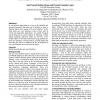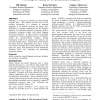GRAPHICSINTERFACE
2003
14 years 1 months ago
2003
We present a gesture-based user interface to Free-Form Deformation (FFD). Traditional interfaces for FFD require the manipulation of individual points in a lattice of control vert...
MBUI
2004
14 years 1 months ago
2004
In conventional applications it is easy to find detailed and structured practices that make use of models in order to describe almost every aspect of the user interface. On the ot...
FLAIRS
2001
14 years 1 months ago
2001
SUITEKeys is a speech user interface for motor-disabled computer users. This interface provides access to all available functionality of a computer by modeling interaction at the ...
EHCI
2001
14 years 1 months ago
2001
Abstract. The increasing proliferation of computational devices has introduced the need for applications to run on multiple platforms in different physical environments. Providing ...
ICAD
2004
14 years 1 months ago
2004
This paper describes a design approach for creating generic computer user interfaces with spatial auditory displays. It proposes a structured depiction process from formulating mo...
EHCI
2004
14 years 1 months ago
2004
Ubiquitous computing requires a multitude of devices to have access ame services. Abstract specifications of user interfaces are designed to separate the definition of a user inter...
AVI
2006
14 years 1 months ago
2006
Access to real environments is often conditioned by a number of issues, including the skills of the user (i.e. affected by aging, physical and psychological deficiencies, etc.) an...
AVI
2006
14 years 1 months ago
2006
For decades, researchers have presented different adaptive user interfaces and discussed the pros and cons of adaptation on task performance and satisfaction. Little research, how...
AVI
2006
14 years 1 months ago
2006
The paper presents a 3D interactive representation of fairly large picture collections which facilitates browsing through unstructured sets of icons or pictures. Implementation of...
AVI
2006
14 years 1 months ago
2006
The ASPICE project aims at the development of a system which allows the neuromotor disabled persons to improve or recover their mobility (directly or by emulation) and communicati...






